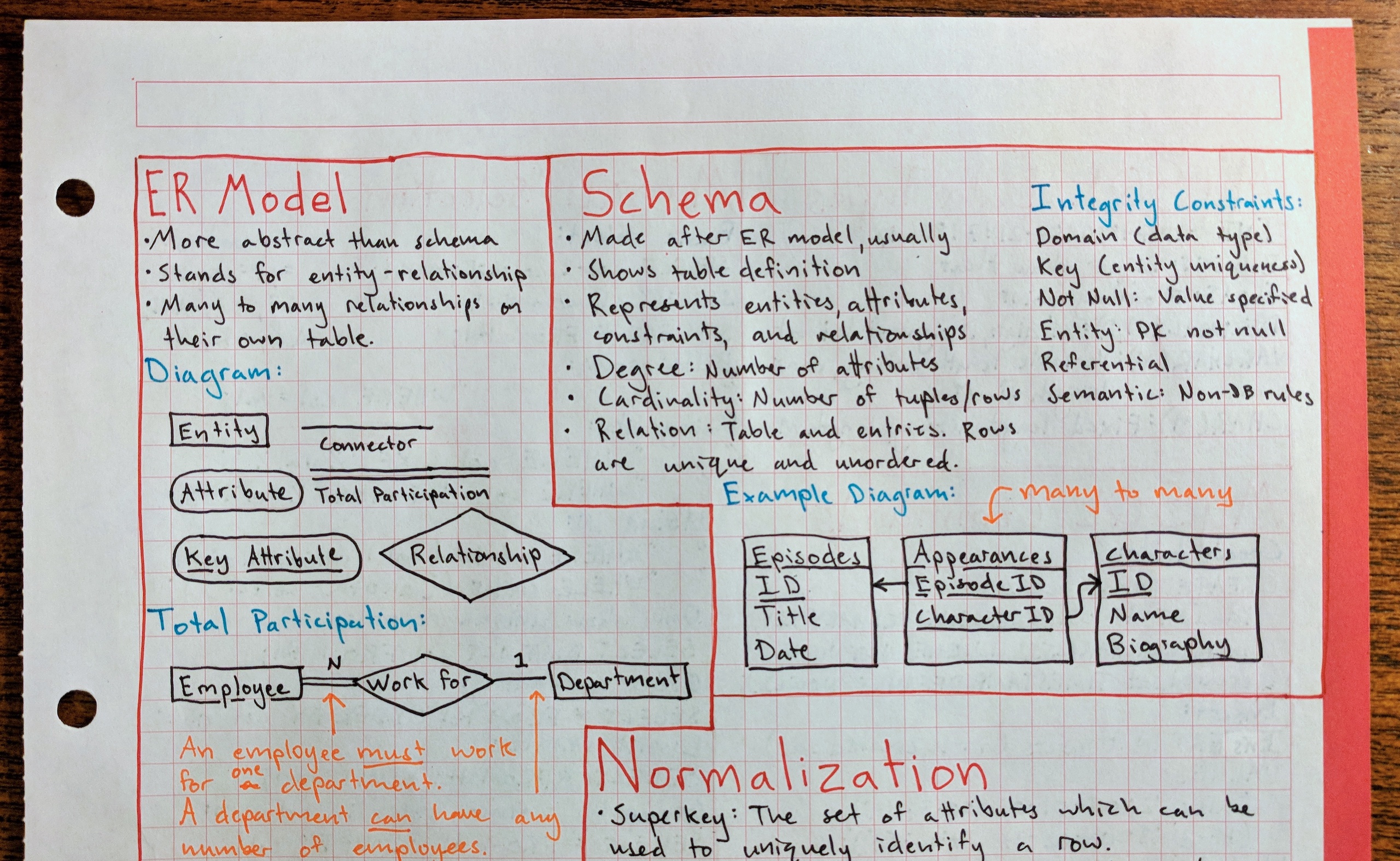 Part of the note sheet that I used for the final.
Part of the note sheet that I used for the final.
This fall I took two courses: Web Development and Databases. This post summarizes my experiences with the latter, and offers some advice for people taking the class in the future.
Instructor
Samarendra Hedaoo
Topics
- Entity-Relationship Models
- Schemas
- Database Normalization
- Object-Relational Mapping
- MySQL
- Keys (Primary and Foreign)
- Joins
- Aggregate Functions
- phpMyAdmin
- Node.js
Preparation
I had some downtime after summer term so I used it to prepare for the classes I took over fall term: databases and web development. For databases, I took this excellent Udemy course by Colt Steele. While it won’t prepare you for the conceptual side of CS 340, it’ll go a long way in getting you comfortable with creating, reading, updating, and deleting data with MySQL. Just make sure you don’t pay full price for it — it goes on sale a lot.
Programming Environment
With the exception of the final project, this course didn’t involve much programming. When I did need to code, I spent most of my time in Sublime Text 3. Occasionally I’d use Cloud9 because I found the interface simpler than phpMyAdmin (to use MySQL, create a new HTML5 workspace and then from the terminal type mysql-ctl cli – this sets up a command-line interface for MySQL through which you can create and use databases).
When I needed files from FLIP I’d download them with Cyberduck. This was especially useful for the final project, when I was constantly downloading files, changing them, and then re-uploading.
It was easy enough to run my Node apps on Oregon State’s FLIP server, so I never ran them locally, although I did install Node so that I could run simple JavaScript apps from my command-line.
Here are some commands I found to be helpful when setting up and running Node servers on FLIP.
Install forever to run Node servers continuously:
npm install forever
Start a forever process to run a Node server continuously:
./node_modules/forever/bin/forever start [file.js] [port]
Show currently running Node servers (must run from whichever folder contains your node_modules folder):
./node_modules/forever/bin/forever list
Assignments
None of the assignments were particularly difficult, though the final project did take up a fair bit of time. Here are a few examples of tasks we had to complete for assignments:
- Get a Node server running and connect it to a MySQL database
- Create a plan for the final project
- Create schemas and ER diagrams
- Select certain entities from a given database
- Convert MySQL queries to relational algebra statements and vice versa
The final project required creating a database that modeled something with a variety of tables. The database was required to have C.R.U.D. functionality: it had to be possible to create, read, update, and delete data. My groupmate and I chose to model the Game of Thrones universe, with tables representing characters, houses, appearances, locations, and episodes. Styling wasn’t necessary, but I had gained some experience with the Bulma CSS library in my web development class and so we used it to make our website a bit prettier. You can see the final product here (after connecting to Oregon State’s network via VPN), at least until they delete it.
 A screen-capture of my final project.
A screen-capture of my final project.
Quizzes
There were six quizzes, but they were unproctored, open-note, and could be taken as many times as necessary, so it’s probably more accurate to describe these as assignments.
Exam
This class had a final and no midterms. The final was somewhat difficult but I had done well on all of my assignments so I wasn’t too worried about acing it. We were allowed a hand-written sheet of notes, which was useful.
Another thing that helped on the exam was creating a few flashcards for each week of the course and reviewing them every day. It only takes a few minutes but goes a long way in helping me remember things. I use an app called Anki.
Extra Resources
In addition to the resources I’ve already mentioned (Udemy, Cloud9), I used LeetCode to practice MySQL queries.
Difficulty and Time Commitment
This course was straightforward and not particularly difficult. I spent 86 hours on the course over the entire semester, including the Udemy course I took at the beginning of the term. That works out to a little under nine hours per week. If I had decided against doing the Udemy course and had done the bare minimum for my final project, I probably could’ve gotten this down to about 60 hours or so.
Enjoyment
You won’t find me creating and maintaining databases in my spare time, but one thing that I came to enjoy about this course is that it’s specifically oriented toward solving problems. I don’t mean problems in the general sense, I mean small, discrete problems like “Given a database which represents a video rental store, find the most and least popular dramas.” That’s not the whole class, obviously, but it’s still fun.
I also enjoyed completing the final project, in large part because I had a good working relationship with my partner. I felt like we created a good product together.
The course wasn’t quite as well-organized as others I’ve taken from Oregon State (CS 271, CS 290) but it wasn’t the worst, either.